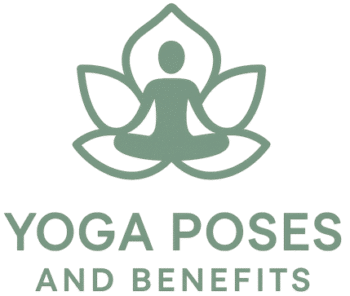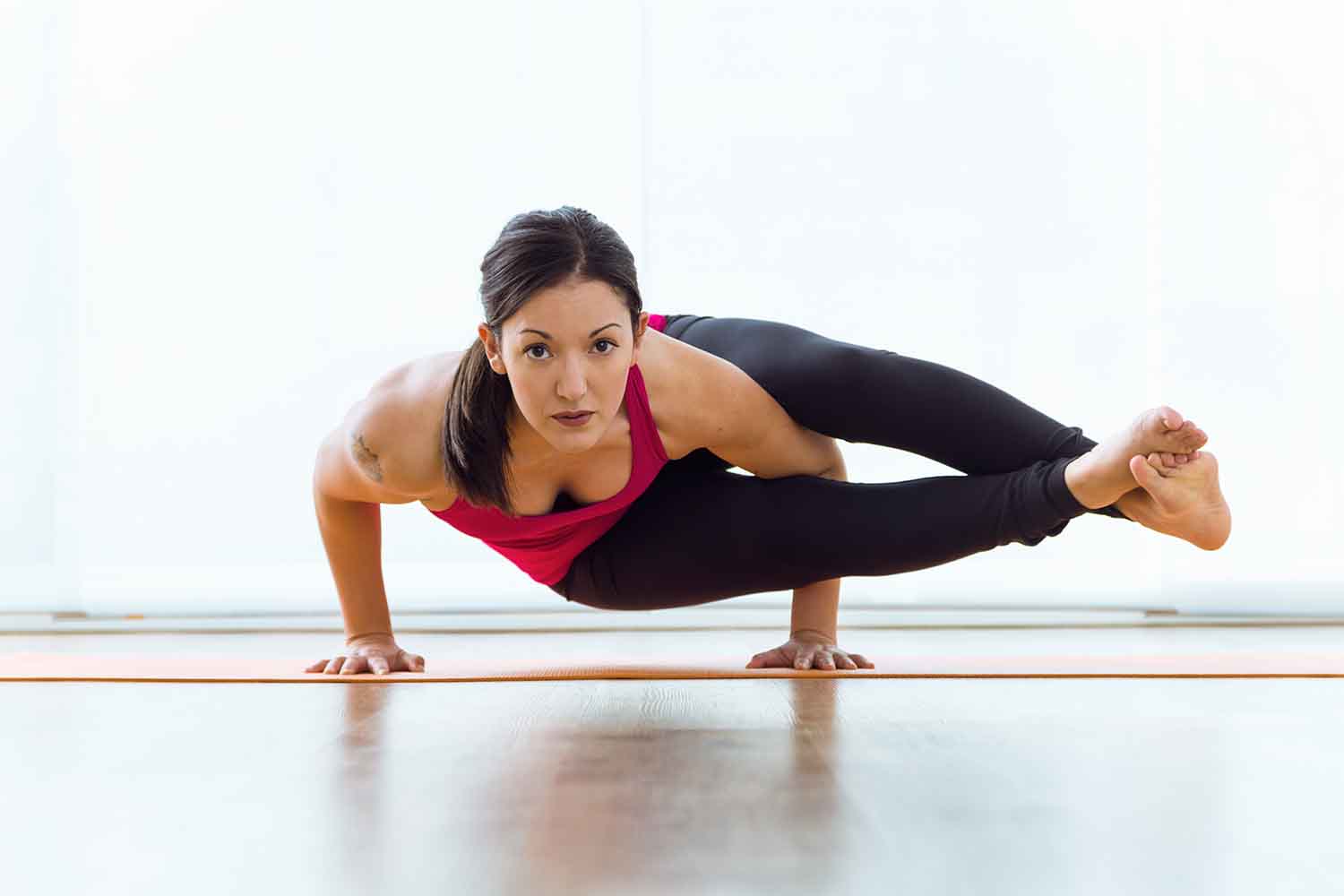Eight Angle Pose in yoga, known as Astavakrasana in Sanskrit, is an advanced arm balance that builds core strength, shoulder stability, and mental focus. Named after the sage Astavakra, this challenging pose combines a twist with an arm balance, making it both physically and mentally invigorating.
Other Names for Eight Angle Yoga Pose
- Astavakrasana
- Eight-Limbed Pose
How to Do Eight Angle Pose in Yoga
To enter Eight Angle Pose, follow these steps:
- Begin in Seated Position: Sit on the mat with your legs extended forward. Bend your right knee and place the right foot on the floor.
- Set Up the Twist: Lift your right leg and thread your right arm under your thigh, placing your right knee over your right shoulder. Use your left hand for balance as you lift your right leg higher onto your shoulder.
- Plant Your Hands Firmly: Place your hands on the mat, shoulder-width apart, with your fingers spread wide. Lean forward slightly to engage your core.
- Cross the Ankles: Hook your left ankle over your right ankle. This will help to stabilize the position.
- Lift Off the Mat: Press into your palms, engage your core, and lift your hips off the ground. Straighten your legs out to the right side as you extend them.
- Hold and Breathe: Keep your gaze forward, hold the position for a few breaths, and gradually release by bending your elbows to lower back down. Switch sides to balance your practice.
Key Alignment Points:
- Keep your core engaged to support your lower back.
- Focus on keeping your shoulders steady.
- Keep your legs actively extended for stability.
Variations of Eight Angle Pose
- One-Legged Eight Angle Pose: Practice lifting one leg at a time instead of crossing your ankles, which can be easier for beginners.
- Forearm Eight Angle Pose: Lower down onto your forearms if holding weight on your hands feels challenging, although this reduces the height and twist intensity.
- Easier Entry from Side Crow: Begin in Side Crow Pose, then work toward extending the legs out to the side as a stepping stone toward full Eight Angle Pose.
Modifications for Eight Angle Pose
- Use a Strap: If your hamstrings are tight, place a strap around your thigh for extra support when threading the arm underneath.
- Start from Seated Forward Fold: Bend one knee and practice lifting the knee over the shoulder. This preparatory movement helps with flexibility and balance.
- Try Using Blocks: Place your hands on blocks to elevate your body and make the lift-off easier. This can also help reduce wrist strain.
Contraindications for Eight Angle Pose in Yoga
Avoid or modify Eight Angle Pose if you experience the following:
- Wrist Injuries: The pressure on the wrists can aggravate injuries. Practice with wrist support or opt for an alternative arm balance.
- Shoulder Pain: The pose requires shoulder strength and flexibility. If you experience discomfort, work on preparatory poses first.
- Lower Back Issues: The twisting motion may put strain on the lower back. Focus on developing core strength and try gentler twists before attempting this pose.
Tips to Improve Eight Angle Pose in Your Practice
- Build Core Strength: Since Eight Angle Pose relies on core stability, practice strengthening poses such as Boat Pose and Plank Pose regularly. A strong core supports balance and helps lift your legs more easily.
- Improve Hip Flexibility: Open your hips with poses like Pigeon Pose and Lizard Pose to make it easier to bring the knee over your shoulder.
- Engage Your Legs: Keep your legs strong and active throughout the pose, especially when extending them to the side. This helps maintain balance and form.
- Focus on Alignment: As you enter the pose, maintain a straight back and avoid collapsing your shoulders. Strong alignment ensures a safe and steady practice.
- Start Slowly: Don’t rush into the full extension. Work through modifications and preparatory poses, focusing on alignment and strength before progressing to the full pose.
- Breathe Deeply: In challenging poses, breath control is key. Take slow, steady breaths to calm the mind and maintain stability in the pose.
What Muscles Does Eight Angle Pose Work?
Eight Angle Pose is a powerful strengthener, engaging multiple muscle groups:
- Core Muscles (Abdominals and Obliques): The twist and lift engage both the upper and lower core.
- Arms and Shoulders (Deltoids, Triceps): Supporting your weight on your hands requires significant arm and shoulder strength.
- Legs (Adductors and Hamstrings): Extending the legs sideways while keeping them engaged strengthens the inner thighs and hamstrings.
- Wrists and Forearms: Holding your body weight engages the wrists and forearms, helping to build stability over time.
Mental and Emotional Benefits of Eight Angle Pose in Yoga
- Builds Mental Focus: Balancing in Eight Angle Pose requires concentration, which improves mental clarity and sharpens focus.
- Increases Resilience: The physical challenge of the pose can build mental resilience, as it requires patience and perseverance to master.
- Boosts Confidence: Achieving this advanced pose can enhance self-confidence and a sense of accomplishment, encouraging you to tackle more challenges.
- Promotes Mindfulness: The coordination and focus required help you stay present, grounding your practice in mindfulness and awareness.
Is Eight Angle Yoga Pose Suitable for Beginners?
Eight Angle Pose is an advanced pose, but beginners can work toward it with consistent practice and modifications. Here’s how:
- Use Preparatory Poses: Focus on strengthening poses like Plank, Crow, and Side Crow to build arm strength and balance.
- Practice Hip Openers: Hip-opening poses such as Garland Pose and Lizard Pose help improve the flexibility needed for Eight Angle Pose.
- Try Supported Variations: Use blocks for support or keep one foot on the ground while practicing the lift to gradually build strength and stability.
Is Eight Angle Yoga Pose Suitable for Advanced Practitioners?
Eight Angle Pose is well-suited for advanced practitioners seeking to deepen their arm balance practice. Advanced yogis can explore:
- Extended Holds: Holding Eight Angle Pose for longer builds endurance and mental focus.
- Transitions: Work on transitioning into Eight Angle Pose from Side Crow or transitioning out into another arm balance for a more dynamic practice.
- Incorporate Leg Lifts: Add intensity by lifting the legs higher once in the pose, increasing the core engagement and balance challenge.
How Does Eight Angle Pose Contribute to a Yoga Sequence or Flow?
Eight Angle Pose adds a unique element to advanced yoga flows, as it combines strength, balance, and flexibility. Here’s how it contributes:
- Strengthens the Core and Upper Body: This arm balance builds the core, arm, and shoulder strength needed for other advanced postures, making it ideal in strength-focused sequences.
- Improves Coordination and Balance: Practicing Eight Angle Pose sharpens coordination and balance, benefiting overall alignment and body awareness.
- Adds Dynamic Transitions: Use Eight Angle Pose to transition into other arm balances or back into seated poses, enhancing the flow’s complexity and dynamism.
- Provides a Mental Challenge: The focus required for Eight Angle Pose can serve as a peak moment in a challenging sequence, pushing both mental and physical limits.
How Can I Deepen My Practice in Eight Angle Pose?
- Develop Core and Arm Strength: Practice core-focused poses like Boat Pose and Side Plank to build the strength required for Eight Angle Pose.
- Increase Hip Flexibility: Work on hip openers, such as Pigeon Pose and Frog Pose, to improve mobility and make it easier to bring your knee over your shoulder.
- Extend Hold Time Gradually: Build endurance by holding the pose for longer periods, increasing your strength and stability.
- Incorporate Dynamic Movements: Add challenge by transitioning from Eight Angle Pose into other arm balances, enhancing both strength and fluidity.
Common Mistakes in Teaching Eight Angle Yoga Pose
- Not Engaging the Core Fully: Without proper core engagement, the pose can strain the lower back. Emphasize the importance of drawing the navel in to support the spine.
- Misaligning the Shoulders: Collapsing the shoulders can lead to instability and strain. Encourage students to keep their shoulders active and away from their ears.
- Relying on Flexibility Over Strength: Many students focus more on getting the leg over the shoulder rather than balancing strength and flexibility. Encourage gradual progress with strength-building poses.
- Skipping Warm-Up: Eight Angle Pose requires warm muscles. Begin with preparatory poses that activate the shoulders, hips, and core.
By focusing on these alignment tips and practicing preparatory movements, practitioners can build the strength and flexibility needed for Eight Angle Pose. With dedication, this challenging pose can become a powerful addition to their yoga practice.
Which pose is best for weight loss?
The best pose for weight loss is one that builds strength, boosts metabolism, and increases heart rate. Examples include Eight Angle Pose, Boat Pose, and Chair Pose. These yoga postures activate core muscles, improve balance, and enhance calorie burn, making them effective tools for supporting weight management goals.
What is the spiritual meaning of the Eight-Angle Pose?
The spiritual meaning of the Eight-Angle Pose, or Astavakrasana, symbolizes inner strength, balance, and transformation. Rooted in yogic philosophy, it reflects the journey of overcoming obstacles through focused discipline, as seen in texts like the Yoga Sutras. This arm balance activates the Manipura Chakra, enhancing personal power and mental clarity.
Is Eight-Angle Pose safe for beginners?
Eight-Angle Pose, or Astavakrasana, is an advanced arm balance pose typically not recommended for beginners due to the strength, flexibility, and balance it requires. Without proper guidance from a certified yoga instructor, attempting this pose can increase the risk of injury to the wrists, shoulders, or lower back.
What are common mistakes in Eight-Angle Pose?
Common mistakes in Eight-Angle Pose include improper core engagement, collapsing the chest, and misalignment of the elbows and shoulders. Practitioners often neglect using foundational arm balance techniques from poses like Chaturanga, and fail to maintain steady breath control, which is essential for stability in Astavakrasana.
Does Eight-Angle Pose build core strength?
Yes, Eight-Angle Pose (Astavakrasana) builds core strength by engaging the abdominal muscles, obliques, and hip flexors to support the body’s weight. This advanced arm balance also activates the shoulders and triceps, enhancing stability and control essential in many yoga practices like Vinyasa or Ashtanga yoga.

